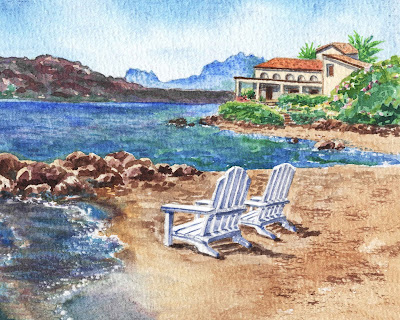Two Chairs On The Beach - Sardinia Italy - Watercolor
When I painted this watercolor artwork I thought about the solitude but not for one, for two people, and some wonderful relaxing times. These two white chairs on the shore invite the viewer to be part of the scenery, bring a friend and enjoy the sea view on the beach.
This scene is on the island of Sardinia, in Italy. But it can be anywhere in the World, where there a breeze, water, mountains, and nobody around but two good friends relax, have a good conversation, melt under the warm sun, absorb the beauty of the Nature.
Thanks to the World Wide Web, here is a historical information and interesting facts about Sardinia:
Sardinia is the second-largest island in the Mediterranean
Sea, after Sicily, and one of the 20 regions of Italy. It is located west of
the Italian Peninsula, north of Tunisia and immediately south of the French
island of Corsica.
It is one of the five Italian regions that have been granted
some degree of domestic autonomy by special statute. Its official name is
Regione Autonoma della Sardegna (Sardinian: Regione Autònoma de Sardigna;
English: "Autonomous Region of Sardinia"). It is divided into four
provinces and a metropolitan city. The capital of the region of Sardinia — and
its largest city — is Cagliari. Sardinia's indigenous language and the other
minority languages spoken on the island (Sassarese, Gallurese, Algherese Catalan
and Ligurian Tabarchino) are officially recognized by the regional law as
having "equal dignity" with Italian.
Sardinia has been inhabited since the Paleolithic. The
island's most iconic civilization is the indigenous Nuragic, which flourished
from the 18th century BC to either 238 BC or the 2nd century AD in some parts
of the island, and to the 6th century AD in that part of the island known as
Barbagia. After a period in which the island was ruled by a political and
economic alliance between the Nuragic Sardinians and the Phoenicians, parts of
it were conquered — by Carthage in the late 6th century BC — and by Rome in 238
BC. The Roman occupation lasted for 700 years. Beginning in the Early Middle
Ages, the island was ruled by the Vandals and the Byzantines. In practice, the
island was disconnected from the scope of Byzantium's territorial influence, so
the Sardinians provided themselves with a self-ruling political organization,
which led to the formation of the kingdoms known as the four Judicates. The
Italian maritime republics of Pisa and Genoa struggled to impose political
control over these indigenous kingdoms, but it was the Iberian Crown of Aragon
which, in 1324, succeeded in bringing the island under its control, consolidating
into the Kingdom of Sardinia. This Iberian kingdom endured until 1718, when it
was ceded to the House of Savoy and later politically merged with the other
Savoyard domains on the Italian Mainland. Later, during the period of Italian
unification, the Savoyards expanded their territory to include the entire
Italian peninsula. They renamed their territory the Kingdom of Italy in 1861,
and it was reconstituted as the present-day Italian Republic in 1946.
Due to the variety of Sardinia's ecosystems, which include mountains, woods, plains, stretches of largely uninhabited territory, streams, rocky coasts, and long sandy beaches, Sardinia has been metaphorically described as a micro-continent. In the modern era, many travelers and writers have extolled the beauty of its long-untouched landscapes, which retain vestiges of the Nuragic civilization.
As an artist I present more than five thousand paintings in different galleries on my website.








